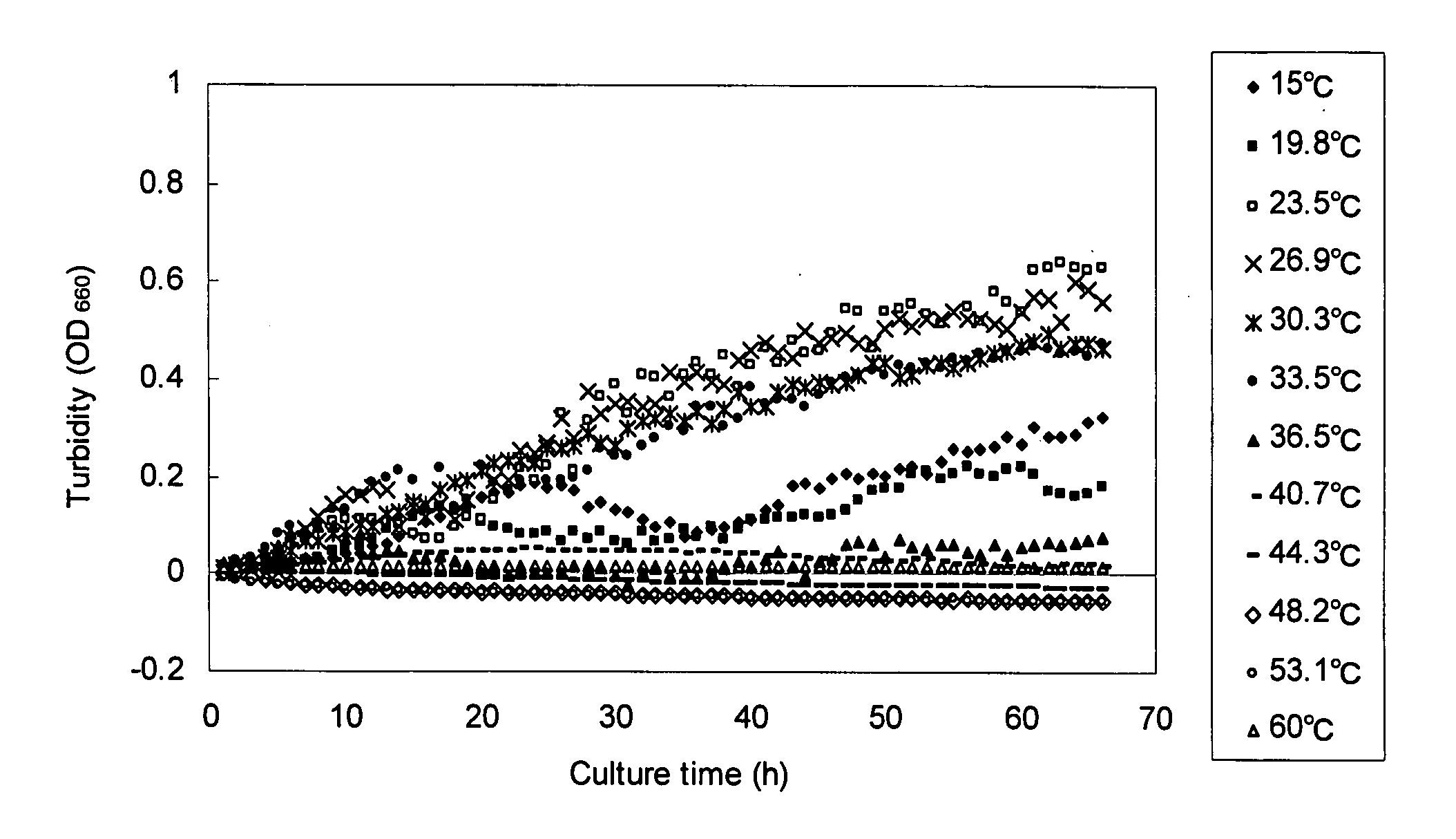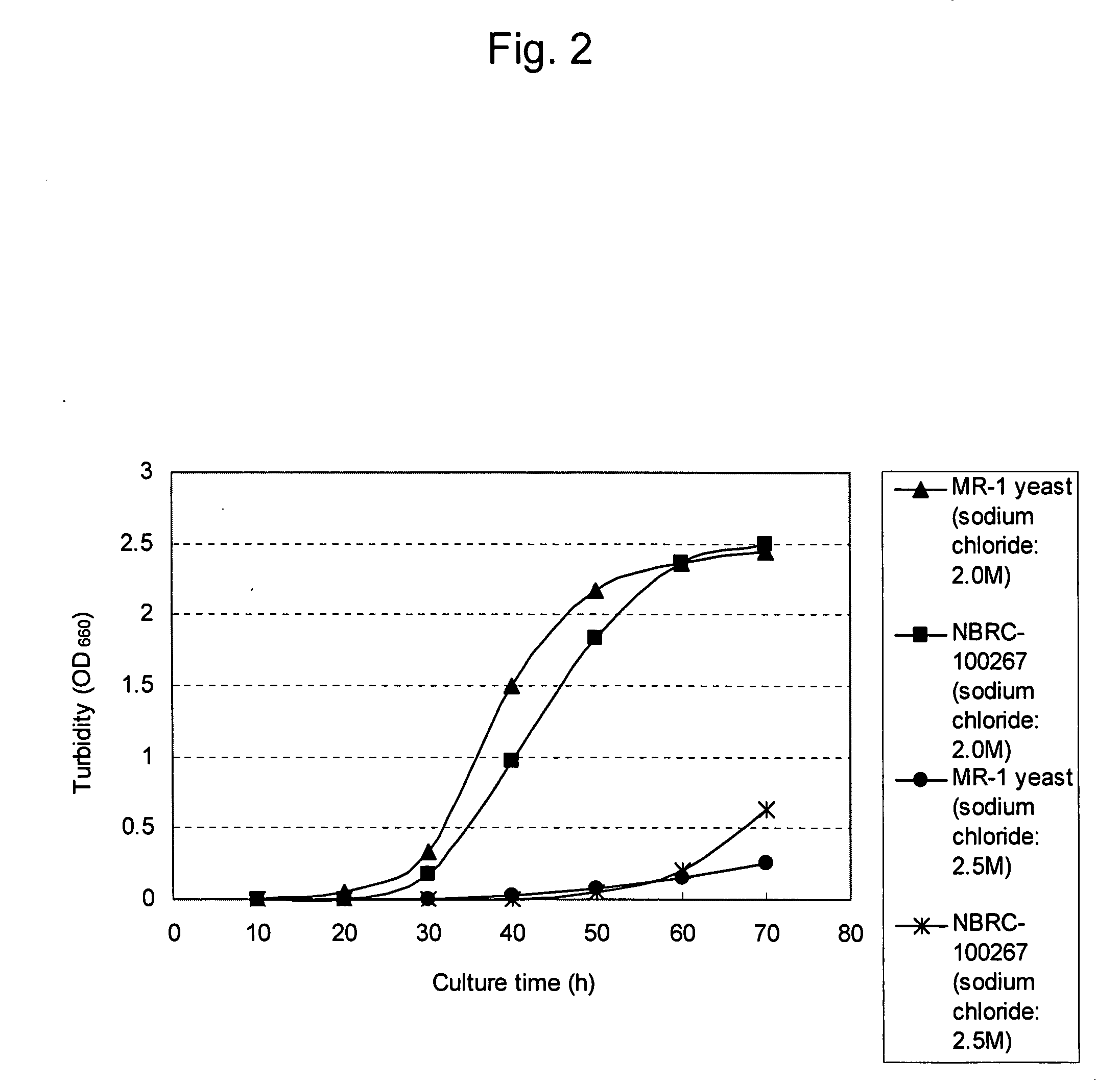Method For Producing Y-Aminobutyric-Acid-Containing Food And Yeast Having High Ability To Produce Y-Aminobutric Acid
a technology of yaminobutyric acid and yaminobutyric acid, which is applied in the field of producing yaminobutyric acid-containing food and yeast having high ability to produce yaminobutyric acid, can solve the problems of lack of versatility, difficult to say, and inability to expect further systematic functional effects to be exerted, so as to achieve the effect of easy mass production
- Summary
- Abstract
- Description
- Claims
- Application Information
AI Technical Summary
Benefits of technology
Problems solved by technology
Method used
Image
Examples
reference example 1
[0053]Pichia anomala MR-1 is a kind of marine yeasts isolated from seawater of Hachinohe offing, Japan, in accordance with following procedures.
[Separation from Seawater]
[0054]First, approximately 50 liters of seawater at a water depth of 5 meters was collected with the use of a sterile water sampler on a ship located offshore of Hachinohe (approximately 15 kilometers away from the seacoast of Aomori, Japan). The seawater was transported under a low temperature at which the seawater remained unfrozen. On the next day, the seawater was filtered with 0.45 μm sterile membrane filters. Microorganism cells which remained on the filters were suspended in 15 ml of sterile distilled water and were used as a sample containing the cells isolated from seawater for the following experiments.
[0055]Each 200 μl were taken out from the samples (15 ml) above and spread onto plates of the YPD agar culture medium, which were used to culture of salt-resistant yeast, containing 2% glucose, 2% peptone, 1...
reference example 2
Reconstitution of the Preserved Strain
[0068]The MR-1 strain that had been preserved in a frozen or freeze-dried state was thawed at room temperature. Cells were collected with the use of a platinum loop. Then, the cells were dispersed in approximately 1 ml of sterilized water so as to be subjected to streak inoculation on a YPD agar medium, followed by culture at 25° C. for 5 days. Accordingly, MR-1 cells were obtained in the form of a milky circular colony on the medium. Such cells can be directly used for preculture as described below. In addition, the strain on the agar medium can be used for preculture with the proviso that it has been refrigerated at 5° C. to 10° C. for a period of 2 months or less.
[Preculture]
[0069]Cells were collected from the colony of the agar medium. The cells were used to inoculate a sterilized YPD liquid medium (200 ml) in an Erlenmeyer flask, followed by shake culture at 25° C. for 2 to 3 days. During the culture, 1 ml of the culture solution was taken ...
example 1
[0094]In accordance with the method for main culture in Reference example 2 above, 7 liters of a liquid medium was placed in a 10-liter jar fermentor, followed by sterilization. Then, 0.7 g of the MR-1 strain obtained in Reference example 2 was used to aseptically inoculate the liquid medium, followed by aeration culture at pH 5.0 and 30° C. for 2 days. The resulting culture solution was centrifuged and the cells were washed with sterilized water. Accordingly, 160 g of MR-1 cells (moisture content: 79.2%) were obtained. The cells were dispersed in 8 liters of a reaction solution containing glucose (3.0%) and glutamic acid (0.5%). The resultant was subjected to a GABA production reaction for 24 hours while being shaken at 45° C. Thereafter, the reaction solution was inactivated by heating at 85° C. for 15 minutes, followed by centrifugation. The supernatant was filtered and vacuum-concentrated. Thus, 800 ml of a concentrate with a solid content of 40% was obtained. In addition, analy...
PUM
| Property | Measurement | Unit |
|---|---|---|
| temperature | aaaaa | aaaaa |
| concentration | aaaaa | aaaaa |
| constant volume | aaaaa | aaaaa |
Abstract
Description
Claims
Application Information
 Login to View More
Login to View More - R&D
- Intellectual Property
- Life Sciences
- Materials
- Tech Scout
- Unparalleled Data Quality
- Higher Quality Content
- 60% Fewer Hallucinations
Browse by: Latest US Patents, China's latest patents, Technical Efficacy Thesaurus, Application Domain, Technology Topic, Popular Technical Reports.
© 2025 PatSnap. All rights reserved.Legal|Privacy policy|Modern Slavery Act Transparency Statement|Sitemap|About US| Contact US: help@patsnap.com



